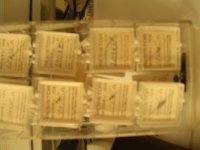Scott, I cited 1966 with the Mead Killion article. What is YOUR SOURCE?
First principles, or did you miss that class? Try Nyquist 1928.
John at least read Mead's abstract, he states that now (1966) good FET's are available the G Ohm resistors are practical. I assume they were not practical as the grid leaks on the triodes that went before (SY is that so ?). So in essence he states at the start that this was well known.
Last edited:
Yes Richard, Scott's article was high quality and informative. However, it would not overexcite someone who has designed microphone electronics before, like B&K, or even me. That is why I usually don't comment openly on the articles published by Jan Didden. There is little to say, from my position on the different topics. The only REAL breakthrough that I have gotten from Jan's publication is from Ed Simon's input. Now he surprises me, sometimes. '-)
In the context Scott put it, it is very good engineering including some new design ideas. A lot of performance bang for the dollar. Was it the best he or anyone else could ever do? That was not my comment.
And, it is not my reflection on anyone else's work who might have been doing highest-end design nor cost no object product development to make it thee best possible ever.
I note too that B&K did more than microphones... and also beyond just the preamp - they much of the test equipment to go along with the measurement microphones and standards work. So, how could one begin to compare. -Thx-RNMarsh
Last edited:
I assume they were not practical as the grid leaks on the triodes that went before (SY is that so ?).
For some very specialized triodes (electrometer tubes), or ones where there's bootstrapping (e.g., in a follower with the grid resistor returned back to a tapping on the load). ~0.1uA is pretty common for grid current in ordinary triodes.
I'll bow to your greater experience ... !It's vice verse, Frank: small omnis on vocals sound sooo boooring.
But if to stick the same omnis in human ears and record such a way, they sound totally different!
But, this does remind me ... it's impossible to get sensible measurements about mic distortion anywhere; yes, I know there's a special technique using face to face mics to do the job (?), but no-one actually specifies anything worthwhile of the results.
Or do they ... ?
Frank
Last edited:
That is when you first found out about microphone impedance? Congratulations.
A condenser microphone is a capacitor, what are you trying to say (1928 I was not around then)? What is the noise on a capacitor? Well let's see, one classic text book technique is to integrate the noise on a parallel R C network from 0 to infinity and as R goes to infinity the answer is always KT/C. Guess what the spectrum looks like? This is OLD stuff.
Or what's the current noise of a resistor? Sqrt(4KT/R) gee what does that mean?
Last edited:
I'll bow to your greater experience ... !
But, this does remind me ... it's impossible to get sensible measurements about mic distortion anywhere; yes, I know there's a special technique using face to face mics to do the job (?), but no-one actually specifies anything worthwhile of the results.
Or do they ... ?
Frank
You are talking about reciprocity which only works on some mics. Google will turn up lots of results. This is the accepted lab standards way (as well as the electrostatic actuator method). There is an obvious technique using two tones one coming from each of two speakers so the IM is only from the mic. With care this can be very good.
They were making measurement insrtruments and it didn't matter. B&K technical journal 1972 recommends 10G Ohms BTW.Anybody yet figure out WHY B&K used such a low input Z?
Yes, but who publishes results? A couple of times I hunted around, but all I came across was single figure "nonsense" and the like. What about full spectrum, at different levels, you know, "engineering stuff" ...You are talking about reciprocity which only works on some mics. Google will turn up lots of results. This is the accepted lab standards way (as well as the electrostatic actuator method). There is an obvious technique using two tones one coming from each of two speakers so the IM is only from the mic. With care this can be very good.
Frank
No, they were worried about HUMIDITY!
Even in 1966, the ways to deal with that were known. Electrometers used very high value resistors.
- Status
- Not open for further replies.
- Home
- Member Areas
- The Lounge
- John Curl's Blowtorch preamplifier part II
